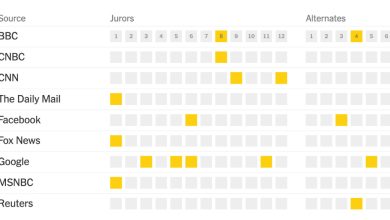How Democrats’ New Maps Could Shape N.Y. Politics for Years to Come

ALBANY, N.Y. — When Huge Ma, better known in New York as Vax Daddy, shut down the website he built last year to help city residents make appointments to get a coronavirus vaccine, he realized there were other more established types of public service to pursue.
So Mr. Ma, a Democrat, decided to run for State Assembly, building off the folk hero status he achieved during the pandemic, with a campaign centered on policy issues he cared about, including transportation and the climate crisis.
But an unexpected twist led Mr. Ma to end his nascent campaign this month just as it was getting underway: When the state’s once-in-a-decade redistricting process was complete, his home was outside the Queens district he hoped to represent.
“While I currently feel a great sense of disappointment,” Mr. Ma wrote on Twitter. “I remain open to representing my community in the future.”
Mr. Ma’s race was just one of many that were shaken up by the State Legislature, which Democrats control, when it approved new legislative maps that will shape the balance of power in Albany for the next decade at least.
The new district lines, which were approved last week, could help fortify Democratic dominance in the statehouse for years to come. They significantly increase the odds that Democrats will protect, and potentially expand, the veto-proof majorities they already command in both the Assembly and Senate, further solidifying New York’s leftward shift.
Republicans contend that Democrats effectively engaged in partisan gerrymandering to keep their grip on power. The state legislative lines, along with new congressional maps, have been challenged in court by a group of voters organized by Republicans.
Rob Ortt, the Republican leader in the State Senate, said in a statement that Democrats had drawn maps “behind closed doors, without considering input from thousands of communities of interest or holding a single public hearing.”
“It is clear they are only concerned with holding onto their political power and cementing the disastrous one-party rule that has made New York less safe, less affordable and less populated,” he said.
State Senator Michael Gianaris, a Democrat who helped lead redistricting efforts in the legislature, has argued that the maps are fair, legal and, in practice, unraveled the results of previous gerrymandering by Republicans.
What to Know About Redistricting and Gerrymandering
- Redistricting, Explained: Answers to your most pressing questions about the process that is reshaping American politics.
- Understand Gerrymandering: Can you gerrymander your party to power? Try to draw your own districts in this imaginary state.
- Killing Competition: The number of competitive districts is dropping, as both parties use redistricting to draw themselves into safe seats.
- New York: Democrats’ aggressive reconfiguration of the state’s congressional map is one of the most consequential in the nation.
- Legal Battles: State supreme courts in North Carolina and Ohio struck down maps drawn by Republicans, while the U.S. Supreme Court temporarily restored Alabama’s map.
“You can’t sit here and say we were wrong, but leave the maps as they are right now,” he said on the Senate floor last week. “That just enshrines that bad behavior into the maps forever. If we’re going to fix the things that you did that were wrong, we have to fix them.”
The maps will also play a pivotal role in Democratic primaries, with the new district lines benefiting some incumbents that left-wing hopefuls had seen as too moderate or entrenched in the party establishment.
That appeared to be the case in Mr. Ma’s district, which is now represented by Assemblywoman Catherine Nolan, a high-ranking Democrat who has served for nearly four decades. The new lines for her district carved out parts of the Long Island City waterfront where some of her most likely challengers, including Mr. Ma, reside.
Political observers said the new district lines could have benefited her in a primary, even though the revamped district includes portions of neighborhoods that might favor a more progressive candidate.
But the race was again upended on Friday when Ms. Nolan, who was diagnosed with cancer last year, announced she would not seek re-election. The seat is now up for grabs, with a number of left-leaning candidates showing interest.
“This obviously locks in the supermajorities, and means that the crux of New York State politics — for interest groups, for labor, for everyone — is going to be the ideological fight among Democrats in a primary,” said Matt Rey, a partner at the political consulting firm Red Horse Strategies. “New York is now moving to the California model.”
Elsewhere in the 150-seat Assembly, which Democrats have controlled since 1975, some of the redrawn lines appear to offer additional protection for other incumbent party members. Others seemed to ensure that tossup races in key suburban areas — including Long Island’s North Shore, the Capitol Region and near Syracuse — remained competitive.
The biggest changes, however, involve the State Senate, where Democrats controlled the redistricting process for the first time in decades after regaining a majority in the chamber in 2018.
The new maps appear to improve Democrats’ chances of flipping at least three Republican-held Senate seats. In a reflection of New York City’s population growth and demographic changes, lawmakers shifted two upstate Senate districts to Brooklyn and Queens. Both are expected to be safe seats for Democrats.
The new lines also give slight edges to Democratic incumbents in highly competitive districts, including on Long Island and in the Hudson Valley, before the November election, when all legislative seats will be on the ballot.
Even so, Democrats’ recent gains in Albany are bound to be tested in significant ways this year, with Republicans — helped by President Biden’s flagging approval ratings and concerns about crime and inflation — poised to perform well in the congressional midterm elections and, potentially, in down-ballot races.
In justifying the new maps, Mr. Gianaris and other Senate Democrats say the lines merely restore the proper balance of power after decades of Republicans drawing maps thatmaximize their waning influence in an increasingly Democratic state.
Senate Democrats insist that their maps more closely follow the spirit of the law, creating districts with more uniform populations after a longstanding practice among Republicans of drawing fewer, highly populous districts downstate for Democrats, and more sparse ones in parts of the state where Republicans could be competitive.
Democrats say another main objective was to unify and strengthen the voting power of so-called communities of interest — ethnic, racial or cultural groups with shared concerns — that they said Republicans had divided over decades to dilute Democrats’ power in the State Senate.
How U.S. Redistricting Works
What is redistricting? It’s the redrawing of the boundaries of congressional and state legislative districts. It happens every 10 years, after the census, to reflect changes in population.
Why is it important this year? With an extremely slim Democratic margin in the House of Representatives, simply redrawing maps in a few key states could determine control of Congress in 2022.
How does it work? The census dictates how many seats in Congress each state will get. Mapmakers then work to ensure that a state’s districts all have roughly the same number of residents, to ensure equal representation in the House.
Who draws the new maps? Each state has its own process. Eleven states leave the mapmaking to an outside panel. But most — 39 states — have state lawmakers draw the new maps for Congress.
If state legislators can draw their own districts, won’t they be biased? Yes. Partisan mapmakers often move district lines — subtly or egregiously — to cluster voters in a way that advances a political goal. This is called gerrymandering.
What is gerrymandering? It refers to the intentional distortion of district maps to give one party an advantage. While all districts must have roughly the same population, mapmakers can make subjective decisions to create a partisan tilt.
Is gerrymandering legal? Yes and no. In 2019, the Supreme Court ruled that the federal courts have no role to play in blocking partisan gerrymanders. However, the court left intact parts of the Voting Rights Act that prohibit racial or ethnic gerrymandering.
Want to know more about redistricting and gerrymandering? Times reporters answer your most pressing questions here.
The end result were lines that, taken together, benefited Democrats.
“An objective analysis would be that, in general, the lines are fairer than they were in the prior reapportionment years, but nobody would say that Joan of Arc drew the lines,” said Bruce Gyory, a Democratic political consultant. “In some new districts, Democrats have made them more compact and contiguous. In other areas, you can say they have loaded up the dice.”
What has been a Republican-held Senate district in the Capitol Region will now connect Saratoga Springs with areas around Albany, including Troy and Schenectady, giving Democrats an advantage. Ithaca, a liberal bastion, was united with Binghamton into one Senate district that should now lean Democratic.
On Long Island, where some of the most competitive races have unfolded in recent years, lawmakers drastically overhauled a district in Suffolk County to give Hispanic voters a plurality. The district has became more favorable to Democrats, who lost it in 2020 amid a pitched battle over public safety and the state’s contentious bail laws.
The new district in Brooklyn, encompassing Windsor Terrace and Chinatown in Sunset Park, has a plurality of voters of Asian heritage, while the new one in Queens, which includes parts of Sunnyside and Richmond Hill, willhave a plurality of Hispanic voters.
Few areas on the current maps inspired as much frustration as Richmond Hill and South Ozone Park in Queens, where South Asian residents mounted a concerted campaign to try to get lawmakers to reunite an area split among seven different Assembly districts. The new maps offers a modest improvement, with most of the area contained in three districts, but local Democratic leaders were not satisfied.
“These maps by State Democrats will perpetuate harm to South Asian and Indo-Caribbean residents who have called South Queens home since the 1960s for at least another decade, and another generation,” Richard David, a Democratic district leader in the area, said.
One shift could prove fortuitous for State Senator Kevin S. Parker, a Brooklyn Democrat, who is facing two challengers from the left. Left-leaning strips of neighborhoods like Park Slope and Windsor Terrace that are currently in his district have been replaced by sections of Brownsville and Canarsie, where the demographics more closely match his base.
“It’s really disheartening, to be honest,” said Samantha Adler, a housing advocate and conflict mediator who is running against Mr. Parker.
“It’s a completely different district,” she said. “Different neighborhoods, different needs.”
Mr. Parker said the new lines returned the district to its proper size, and reunited communities that Republican lawmakers had separated.
“The districts have just been right-sized,” he said. “And I think they’ve been drawn in a way that’s contiguous with the districts in the community that I’ve represented.”
Nicholas Fandos contributed reporting.




